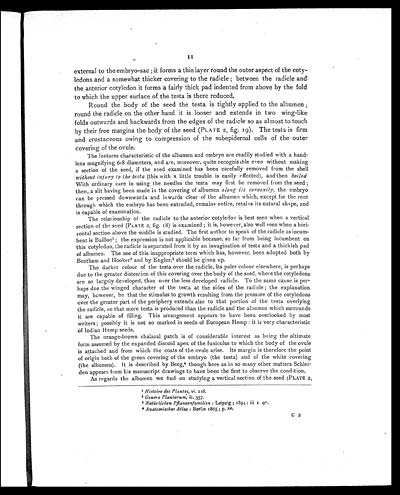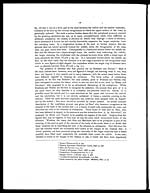Medicine - Institutions > Army health reports and medical documents > Scientific memoirs by officers of the Medical and Sanitary Departments of the Government of India > Number 12 - On the morphology, teratology, and diclinism of the flowers of cannabis > On the morphology, teratology, and diclinism of the flowers of cannabis
(17) Page 11
Download files
Individual page:
Thumbnail gallery: Grid view | List view

11
external to the embryo-sac; it forms a thin layer round the outer aspect of the coty-
ledons and a somewhat thicker covering to the radicle; between the radicle and
the anterior cotyledon it forms a fairly thick pad indented from above by the fold
to which the upper surface of the testa is there reduced.
Round the body of the seed the testa s tightly applied to the albumen ;
round the radicle on the other hand it is looser and extends in two wing-like
folds outwards and backwards from the edges of the radicle so as almost to touch
by their free margins the body of the seed (PLATE 2, fig. 19). The testa is firm
and crustaceous owing to compression of the subepidernal cells of the outer
covering of the ovule.
The features characteristic of the albumen and embryo are readily studied with a hand-
lens magnifying 6-8 diameters, and are, moreover, quite recognisable even without making
a section of the seed, if the seed examined has been carefully removed from the shell
without injury to the testa (this with a little trouble is easily effected), and then boiled.
With ordinary care in using the needles the testa may first be removed from the seed ;
then, a slit having been made in the covering of albumen along its convexity, the embryo
can be pressed downwards and inwards clear of the albumen which, except for the rent
through which the embryo has been extruded, remains entire, retains its natural shape, and
is capable of examination.
The relationship of the radicle to the anterior cotyledon is best seen when a vertical
section of the seed (PLATE 2, fig. 18) is examined; it is, however, also well seen when a hori-
zontal section above the middle is studied. The first author to speak of the radicle as incum-
bent is Baillon1; the expression is not applicable because, so far from being incumbent on
this cotyledon, the radicle is separated from it by an invagination of testa and a thickish pad
of albumen. The use of this inappropriate term which has, however, been adopted both by
Bentham and Hooker2 and by Engler,3 should be given up.
The darker colour of the testa over the radicle, its paler colour elsewhere, is perhaps
due to the greater distention of this covering over the body of the seed, where the cotyledons
are so largely developed, than over the less developed radicle. To the same cause is per-
haps due the winged character of the testa at the sides of the radicle; the explanation
may, however, be that the stimulus to growth resulting from the pressure of the cotyledons
over the greater part of the periphery extends also to that portion of the testa overlying
the radicle, so that more testa is produced than the radicle and the albumen which surrounds
it are capable of filling. This arrangement appears to have been overlooked by most
writers; possibly it is not so marked in seeds of European Hemp: it is very characteristic
of Indian Hemp seeds.
The orange-brown chalazal patch is of considerable interest as being the ultimate
form assumed by the expanded discoid apex of the funiculus to which the body of the ovule
is attached and from which the coats of the ovule arise. Its margin is therefore the point
of origin both of the green covering of the embryo (the testa) and of the white covering
(the albumen). It is described by Berg,4 though here as in so many other matters Schlei-
den appears from his manuscript drawings to have been the first to observe the condition.
As regards the albumen we find on studying a vertical section of the seed (PLATE 2,
1 Histoire des Plantes, vi. 216.
2 Genera Plantarum, iii. 357.
3 Natürlichen Pflanzenfamilien ; Leipzig; 1894: iii 1. 97.
4 Anatomisches Atlas : Berlin 1865; p. 86.
C 2
Set display mode to: Large image | Zoom image | Transcription
Images and transcriptions on this page, including medium image downloads, may be used under the Creative Commons Attribution 4.0 International Licence unless otherwise stated. ![]()
| Permanent URL | https://digital.nls.uk/75026767 |
|---|
| Shelfmark | IP/QB.10 |
|---|---|
| Additional NLS resources: | |




